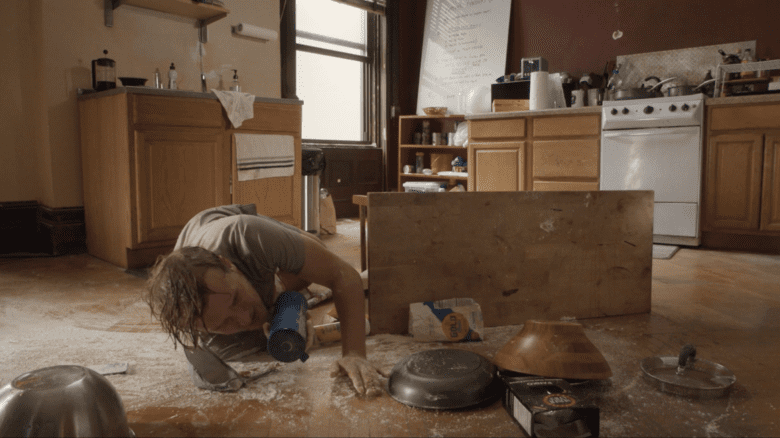Kelly McCray is someone who inspires me because, as an art maven who’s been around in the Toronto art scene awhile, he’s not only aware of its history, he’s forward looking, too. McCray’s an artist who makes his own steamy photographs of men at the baths, and he’s a curator who’s put together some really innovative and sometimes risky exhibitions.
Take his recent coup of getting the US gallery handling the Tom Of Finland exhibition to make Toronto the first stop on an international tour. McCray organized a collaboration between Edward Day and YYZ galleries which saw both hosting the work. For McCray, this joining of forces builds cross-over audiences for the two galleries and succeeds in getting gay art out of the ghetto.
In a recent visit to Edward Day Gallery in Yorkville, where McCray works and has curated its current show LandTakes, I asked him how viewers in this fashionable part of town respond to the Tom Of Finland drawings, a few of which still hang in one of the side galleries.
“New people are coming into the gallery especially to see them,” says McCray. “And the regular clientele is curious. What’s gratifying to me is that people’s understanding of art is being broadened.”
And he’s not worried that the $5,000- to $11,000-price tags don’t have any red dots on them (meaning they’re sold, although two of the sketches are on hold).
These images have taken a curious trajectory from the days when they circulated underground as jerk-off material in the form of card sets and calendars, to their recuperation and celebration in historical and academic publications, to their current elevation to high art objects worth thousands of dollars.
Artworks that were blatantly homoerotic only hit Toronto galleries – primarily artist run centres and collectives – about 20 years ago. Commercial galleries, for the most part, were not interested in supporting this kind of work.
The high octane activity of gay and lesbian artists in the 1980s and ’90s produced work that progressively built a consciousness and politic around our identities. The impact on the art world and queer communities was enormous.
But now, issues of identity have become much more diffuse and bound up with other artistic concerns. The circumstances are often messier. That which once dared not speak its name, can find itself ungraciously tossed out of the old familiar downtown niches by the new radical guard, grown bored with the stridencies and simplicities of identity-based art.
These days, it appears that some of the commercial galleries, in true, Johnny-come-lately style, have opened their doors to openly queer art, vying for our attention and dollars. But that’s not to say each dealer is doing it for the same reasons or with the same knowledge base.
Which is why I’m truly intrigued by Lori Newdick’s current show, Heroine, at Jane Corkin Gallery. Fresh out of the Ontario College Of Art And Design, with a photography award under her belt and under the wing of an artist in Corkin’s roster, Newdick’s been given an opportunity few young artists get – especially if the work they make is obviously about lesbians.
But the work is so anachronistic.
Newdick’s photographic triptychs combine images lifted directly from 1950s lesbian pulp novels (remember how brilliantly Nina Levitt and Lynne Fernie used these images in the 1980s?) with blurry self portraits (remember every other lesbian photographer?) and archival images of proper cravat tying.
What disturbs me is Newdick’s claim, in both the gallery’s press release and a National Post article: Although “Hollywood has made gay culture and visible minorities appear palatable for the mainstream, attitudes toward lesbians have not changed much during the last 50 years.”
Huh?
Midway into her show (when I was there), there were 44 red dots (each representing a $900 sale) on her nine prints.
They are handsome works, saturated in colour and technically accomplished. And she has every right to make, show and sell them. It’s clear she wants to explore her lesbian identity and, fortunately, the 1950s is still a dandy decorating theme for lots of people.
I just wonder what produces the vacuum that sucks into oblivion the historical context that allows her to do just that, without censure and with the full support of such a prestigious gallery.
It’s precisely because of the current mainstream vogue for queer and historical culture that her works are being picked up like hot cakes. It seems what once was “forbidden love” is now “for sale love”… and doing very well, thank you very much.
And I say good! In the mere 15 years I’ve been watching, it’s been painful to see lesbian and gay artists get very little of the green stuff in return for putting their careers and asses on the line.
However, the ongoing attraction of these pulp novel covers is complex. They’ve had their own trajectory, from jerk-off material (in this case, for lesbians and straight men), to recontextualization and analysis in the lexicons of contemporary art and theory.
They’re kitsch, nostalgic, titillating. Like the Tom Of Finland drawings, they’re works about fantasy, historical and read in entirely different ways than originally intended. And now that they’ve been assimilated by the mainstream, they’re no longer threatening.
I have no doubt they’re the main attraction in Newdick’s artworks and why this tony gallery will show them now and, according to the gallery, why all kinds of people – gay, straight, couples – will buy them.
And so I’m not impressed by this indelicate retread playing at serious identity politics. Surely I’m not asking for much – a modicum of reflexivity, a little arch humour, a nod toward the irony of appropriating your own history – but mostly just some inspired movement forward.
 Why you can trust Xtra
Why you can trust Xtra


